Government entities have often been on the periphery when it comes to successfully embrace digital disruption. The nature of public sector operations means organizations are typically owned by governments and primarily focus on providing services to society.
In contrast, private sector organizations have more flexibility in setting their goals and making decisions related to product development, innovation, pricing, and marketing. This often puts pressure on government bodies to modernize inadequate legacy infrastructure and uphold service expectations in the face of regulatory constraints and limited resources.
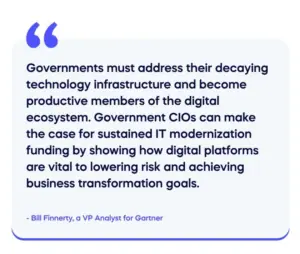
Bill Finnerty, a VP Analyst for Gartner says, “Governments must address their decaying technology infrastructure and become productive members of the digital ecosystem. Government CIOs can make the case for sustained IT modernization funding by showing how digital platforms are vital to lowering risk and achieving business transformation goals.”
Government digital transformation is only as effective as the knowledge and insight of those leading it. Without their constant understanding of the latest relevant trends, digital transformation efforts could fall short or become obsolete. Those in the field must stay actively engaged with the current information from both within and outside of their industry so that their decision-making is based on an up-to-date source of data.
This article explores six digital government transformation trends to watch in 2023. We’ll look at what digital government transformation is, its importance, who is responsible for identifying digital transformation trends in government, and provide tips for securing success with government transformation.
These insights will help you understand the major implications of digital transformation on governments and their citizens worldwide.
Keeping their pulse on these trends ensures that digital transformation initiatives remain effective, relevant, and meaningful for all stakeholders.
What is Digital Government Transformation?
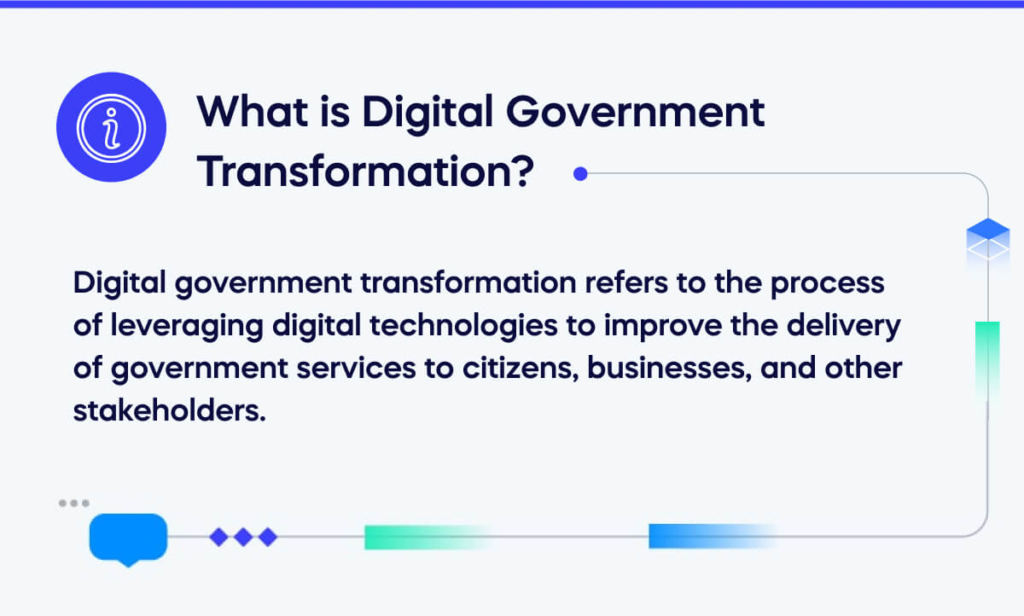
Digital government transformation refers to the process of leveraging digital technologies to improve the delivery of government services to citizens, businesses, and other stakeholders.
This involves transforming how governments operate, interact with citizens and businesses, and deliver services using digital channels such as websites, mobile apps, social media, and other digital tools.
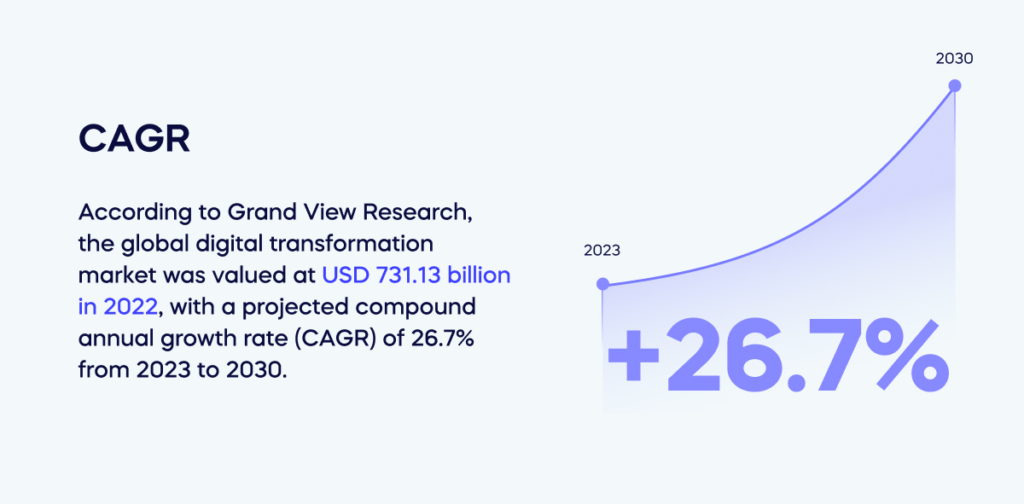
According to Grand View Research, the global digital transformation market was valued at USD 731.13 billion in 2022, with a projected compound annual growth rate (CAGR) of 26.7% from 2023 to 2030.
These figures also reflect current DX efforts within the public sector, which aim to enhance government efficiency, transparency, and accountability and improve citizen engagement and satisfaction. This transformation includes the digitization of government documents, automating government processes, and providing digital services that are accessible and user-friendly for citizens.
6 Digital Government Transformation Trends to Watch in 2023
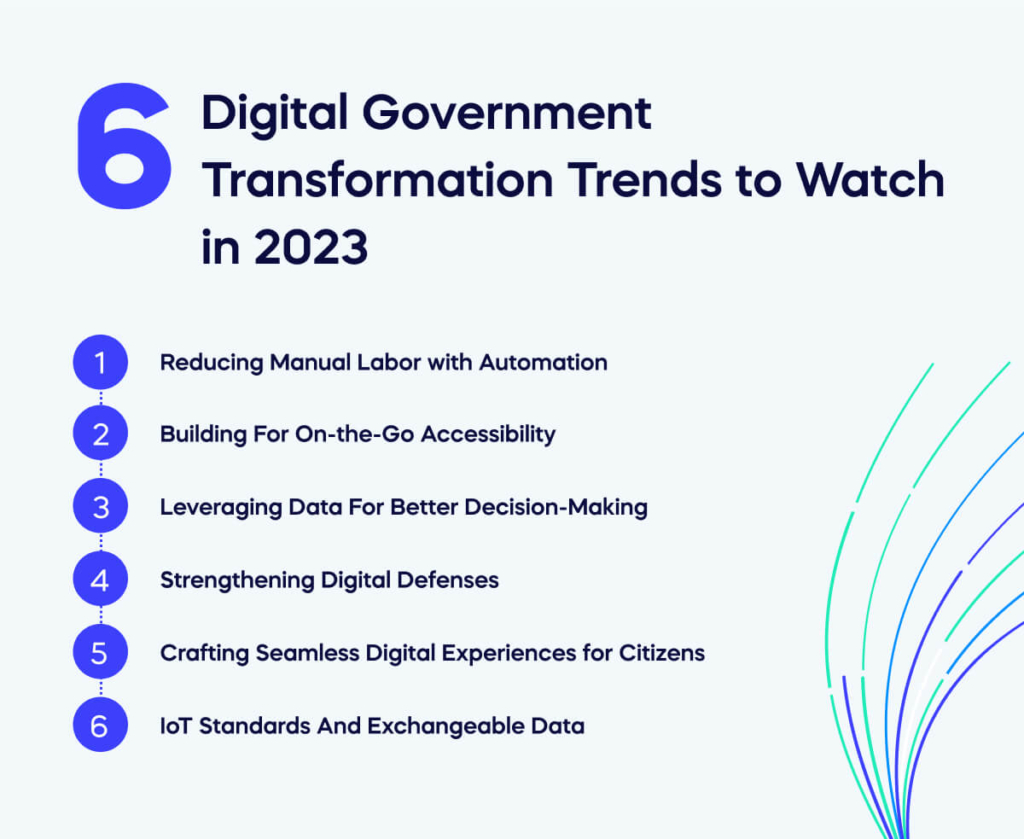
Governments across the globe have been embracing new technologies to improve services, efficiency, and security. As we approach the second quarter of 2023, here are six digital transformation trends that organizations should watch out for:
- Reducing Manual Labor with Automation
- Building For On-the-Go Accessibility
- Leveraging Data For Better Decision-Making
- Strengthening Digital Defenses
- Crafting Seamless Digital Experiences for Citizens
- IoT Standards And Exchangeable Data
- Reducing Manual Labor with Automation
In order to speed up the delivery of services and increase accuracy, governments are increasingly looking for automation solutions. By leveraging robotic process automation (RPA) and artificial intelligence (AI), manual labor can be dramatically reduced while providing a stronger level of quality assurance.
For example, the UK Government Digital Service’s 2021 – 2024 strategy has been highly successful, with departments migrating to the GOV.UK platform and modernizing key services like passport and driver’s license applications. With a budget of £90 million and over 800 personnel, 60% of them are devoted to sustaining existing platforms, services, and content; this includes keeping GOV.UK is accessible, dependable, and up-to-date for millions of British citizens who rely on it.
-
Building For On-the-Go Accessibility
In an increasingly mobile society, governments are looking for ways to make their services available wherever citizens go. Mobile government tech uses tools like cell phones and apps for governmental activities. This field device helps keep government personnel, and officials connected to essential information and data anytime, anywhere, making it simpler to serve their constituency.
Government entities must build for on-the-go access by investing in cloud platforms, mobile apps, and other mobility technology to support this trend.
The US Internal Revenue Service (IRS) has implemented its IRS2Go mobile app on both Android and iOS devices, allowing taxpayers to file their taxes quickly and easily. This app provides a fast and secure way to submit taxes, with the ability to store information from previous years, track refunds in real-time, check the filing status of tax returns, and get help with any IRS inquiries.
It also supports direct deposit into bank accounts, allowing taxpayers to receive refunds faster. In addition to this mobile app, the IRS also offers other digital services, such as online payment plans and webinars for those who need extra assistance during filing season.
-
Leveraging Data For Better Decision-Making
More than ever, governments are leveraging data analytics to derive actionable insights and make better decisions. This includes enhancing predictive analytics capabilities and adopting open data initiatives to share knowledge across departments and public organizations.
In 2018, the U.S. Secretary of Agriculture, Sonny Perdue, was instrumental in the launch of a cutting-edge platform designed to serve the agricultural community. This platform, known as farmers.gov, offers a dynamic and mobile-friendly public website paired with a secure, authenticated portal. Farmers can easily apply for programs, process transactions, and manage their accounts through this portal.
With the collection of data relating to the farmers’ needs and use of the platform, the United States Department of Agriculture (USDA) can rely on data-driven decisions on how to improve the platform and deliver more efficient services to farmers.
-
Strengthening Digital Defenses
Cybersecurity threats pose a particularly dangerous risk to digital government operations as they can result in disabling attacks or even the destruction of valuable data sets. To safeguard against potential threats and vulnerabilities, governments must strengthen their cyber defenses and improve their threat detection and response processes.
The UK Government has unveiled its Cyber Security Strategy for 2022–2030 to ensure the safety of critical infrastructure. This commitment is evident in the 2021 Comprehensive Spending Review, with an investment of £2.6 billion towards cyber and legacy IT technology, including government cyber security.
An additional £37.8 million will be used to tackle any cyber security challenges local councils face, preserving invaluable services and data from harm. Targeted funding will also be assigned to essential departments to protect them from potential threats.
-
Crafting Seamless Digital Experiences for Citizens
In today’s government landscapes, citizens expect seamless digital experiences when engaging with public services online or through mobile applications. To meet these demands, governments must focus on user experience design principles that consider convenience and security, such as introducing identity verification procedures and making them easier to use with biometrics authentication tools like facial recognition or fingerprint scanning).
The Singaporean Government is actively Crafting Seamless Digital Experiences to improve the digital journeys of its users and citizens from end to end. Specifically, the Smart Nation Digital Government Office (SNDGO) has developed several key initiatives to streamline and improve the digital experience for citizens.
For example, the Monetary Authority of Singapore (MAS) seeks to create a Smart Financial Centre where FinTech is widely used, and innovation thrives. E-payments are an integral part of this agenda, with the goal of creating an e-payments society that encourages competition and convenience.
Through these initiatives, the Singaporean Government has created a seamless digital experience that improves user experience and reduces administrative costs while increasing efficiency.
-
IoT Standards And Exchangeable Data
With the increasing emergence of Internet of Things (IoT) devices in smart cities around the world, there needs to be greater emphasis placed on developing standards that enable secure communications between different systems as well as exchangeable data models so stakeholders can easily share information across organizations without hindrance from legacy systems.
In 2022, the European Union approved new legislation to raise the security standard for internet-connected devices and make data exchange between different devices and services more accessible.
The law, known as the Digital Services Act and the Digital Markets Act, imposes several obligations on tech companies that provide IoT devices in the EU market, including requirements for strong cybersecurity measures, transparent and standardized communication protocols, and interconnectivity with other devices and services.
Digital Transformation Trends In Government: Who is Responsible?
Undertaking a digital transformation in government only happens with clear guidance and direction. Government departments, agencies, and organizations must identify the right trends and implement them effectively within their institutions to keep up with changing technology.
It takes an experienced team of professionals to determine which trends are most appropriate for their environment while balancing the cost versus benefit factors associated with each option. And it is this team that ultimately makes sure that these trends are implemented according to best practices.
The team responsible for implementing digital transformation trends in government can vary in size based on the scope of work required. Generally speaking, they would include members from IT, finance, marketing, HR, legal, policy, and other areas depending on the organization’s needs. Each member contributes unique expertise to ensure digital transformation initiatives stay on track and deliver real value to the organization’s goals.
Government departments must dedicate resources to plan for digital transformations effectively. This includes budgeting for new technologies and accounting for changes in organizational operations, such as staff retraining or redeployment of existing teams.
A successful digital transformation requires understanding how best to utilize existing resources and planning for any potential technological challenges during implementation.
As such, there must be a unified vision across all branches of an organization – from top-level leadership down – which should be communicated clearly throughout departments to ensure everyone is working together towards a common outcome.
It’s up to those leading the charge – including IT professionals, finance directors, and operations managers – to create a comprehensive strategy behind every digital transformation trend being considered or implemented in government entities today. With critical thinking applied at every step along the way – from initial research into possible options through implementation – strong governance can provide unparalleled success when transforming government processes digitally for maximum efficiency gains over time.
Tips For Securing Success with Digital Government Transformation
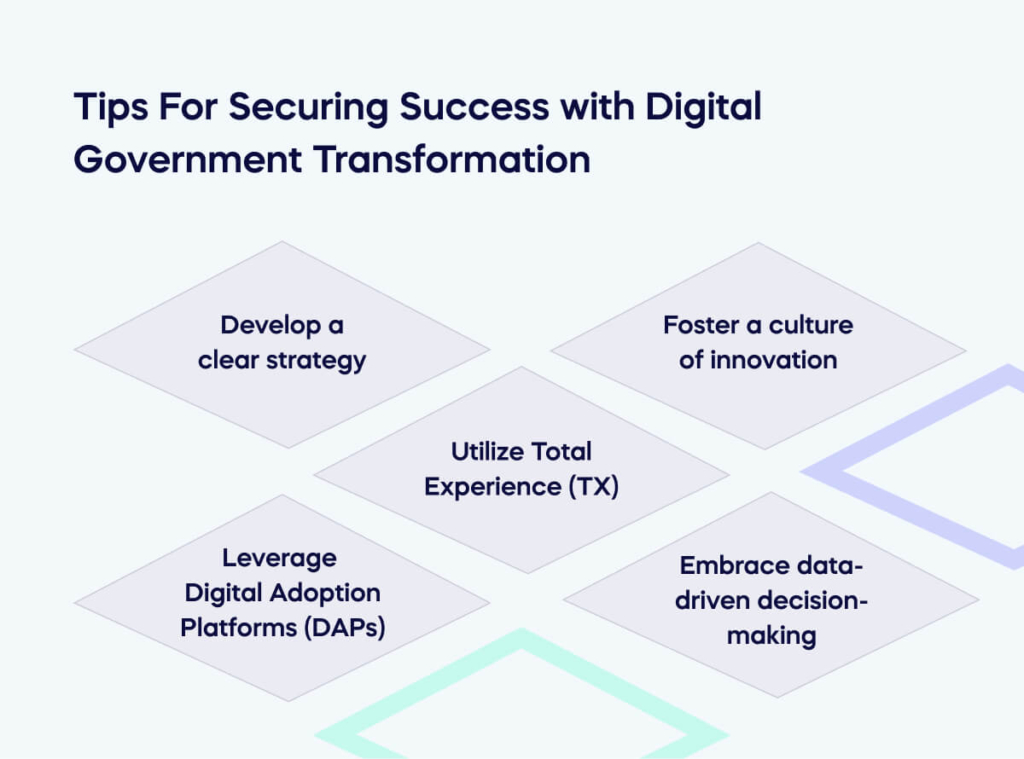
It’s important to note that simply adopting new digital technologies is not enough. To get the most out of digital government transformation, it’s crucial to have a well-thought-out plan that considers all relevant factors and stakeholders.
The complex challenge facing CIOs and digital leaders today is empowering change within the public sector. Luckily, several strategic tips can be leveraged to ensure a successful transformation.
Develop a clear strategy: A well-defined digital transformation strategy is crucial for the success of any government agency. A clear and comprehensive approach should outline the goals, objectives, and steps needed to achieve a successful transformation.
Utilize Total Experience (TX): Total experience (TX) is a holistic approach that integrates customer, employee, and user experience into a seamless whole. Government CIOs are adopting new technologies that connect customer experience (CX), employee experience (EX), multi-experience (MX), and user experience (UX) within a single framework.
This approach aims to enhance the public’s trust in government services by providing seamless and efficient service delivery across all channels. By utilizing TX, government agencies can design and deliver services that meet the needs of their constituents, improve satisfaction and trust, and enhance the overall user experience.
Foster a culture of innovation: Developing a culture within the government agency is crucial in driving digital transformation. Employees must feel empowered to embrace new technologies that can enhance their daily operations, from using digital tools for collaboration to adopting new approaches to solve problems.
Leverage Digital Adoption Platforms (DAPs): DAPs help onboard, train, and support employees on new digital tools and technologies. With DAPs, government agencies can reduce training costs, and minimize user errors and inefficiencies, thereby maximizing the return on investment (ROI) in new tech.
Leveraging digital adoption platforms (DAPs) can significantly enhance the success of government digital transformation initiatives by providing a comprehensive solution for training, guidance, and support. Whether it’s implementing new software, systems, or processes, a digital adoption platform ensures a smooth transition, reducing the potential for errors, delays, and unnecessary costs.
Embrace data-driven decision-making: Data-driven decision-making is essential for the success of any digital transformation effort. Data can provide valuable insights that inform government agencies on where to focus their resources and optimize their operations.
Preparing for the Future of Digital Transformation in Government
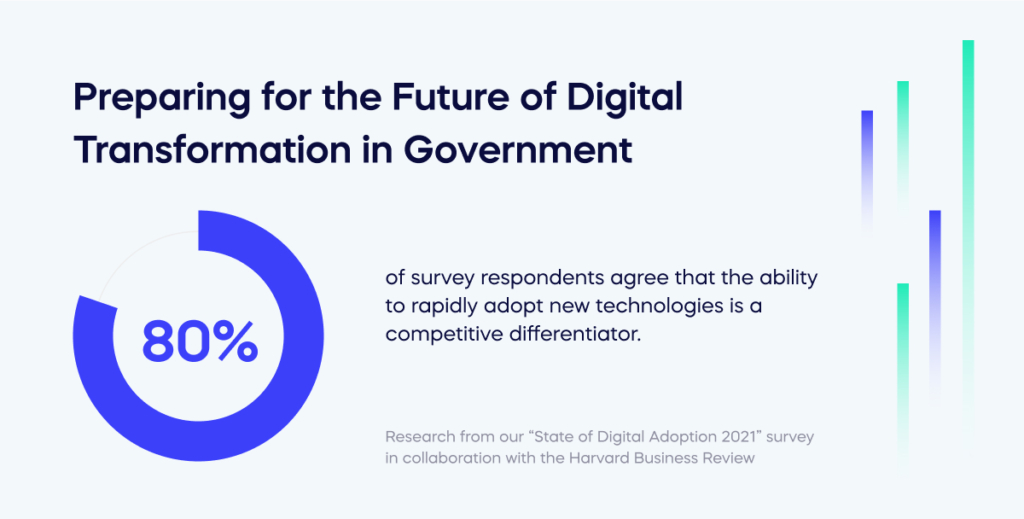
Research from our “State of Digital Adoption 2021” survey in collaboration with the Harvard Business Review shows that while digital adoption is top of mind for executives, employees struggle to operate common software and platforms. 80% of survey respondents agree that the ability to rapidly adopt new technologies is a competitive differentiator.
As such, utilizing a digital adoption platform (DAP) as part of the procurement process is one of many ways government bodies can empower employees with the skills and confidence they need to leverage technology effectively and maximize efficiency. DAPs enable government agencies to accelerate digital transformation, achieving better results and fostering stronger relationships with constituents.
Digital transformation isn’t just about how much technology an organization can procure. It’s about knowing which technology solutions are best suited to remedying the most pressing needs and objectives and how to use them properly.
The public sector may have a reputation for being one step behind. However, by leveraging tools that reduce the learning curve quicker than ever, government entities can finally catch up and become an agile and reliable force within the global digital ecosystem.

